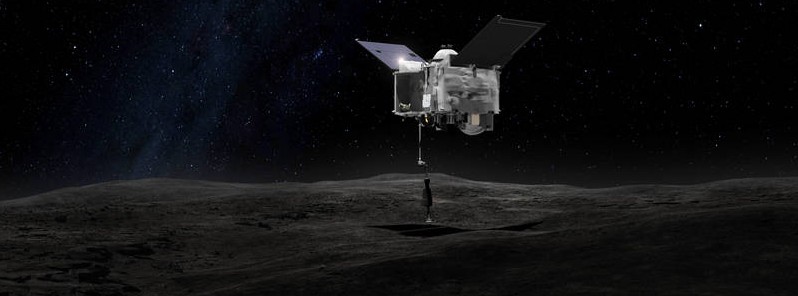OSIRIS-REx to launch toward Asteroid Bennu and come back with its sample in 2023

In September or early October 2016, NASA will launch its first mission to return a sample of an asteroid to Earth. The Origins, Spectral Interpretation, Resource Identification, Security-Regolith Explorer (OSIRIS-REx) spacecraft will travel to the near-Earth asteroid Bennu, collect its sample and bring it back to Earth in 2023. The mission will help scientists investigate how planets formed and how life began, as well as improve our understanding of asteroids that could impact Earth. There is a small probability that Bennu could hit Earth late in the 22nd century.
The 2 110-kg (4 650-pound) fully-fueled spacecraft will launch aboard an Atlas V 411 rocket during a 34-day launch period that begins September 8, and reach its asteroid target in 2018.
After a careful survey of Bennu to characterize the asteroid and locate the most promising sample sites, OSIRIS-REx will collect between 60 and 2 000 grams (2 and 70 ounces) of surface material with its robotic arm and return the sample to Earth via a detachable capsule in 2023.

The OSIRIS-REx mission, launching in September 2016, plans to return a sample of asteroid Bennu to Earth in 2023 so that scientists can study pristine material left over from the early solar system. Dante Lauretta, Principal Investigator for OSIRIS-REx, provides an overview of this asteroid sample return mission.
"The launch of OSIRIS-REx is the beginning a seven-year journey to return pristine samples from asteroid Bennu," said OSIRIS-REx Principal Investigator Dante Lauretta of the University of Arizona, Tucson. "The team has built an amazing spacecraft, and we are well-equipped to investigate Bennu and return with our scientific treasure."
OSIRIS-REx has five instruments to explore Bennu:
- OSIRIS-REx Camera Suite (OCAMS) – A system consisting of three cameras provided by the University of Arizona, Tucson, will observe Bennu and provide global imaging, sample site imaging, and will witness the sampling event.
- OSIRIS-REx Laser Altimeter (OLA) – A scanning LIDAR (Light Detection and Ranging) contributed by the Canadian Space Agency will be used to measure the distance between the spacecraft and Bennu's surface, and will map the shape of the asteroid.
- OSIRIS-REx Thermal Emission Spectrometer (OTES) – An instrument provided by Arizona State University in Tempe that will investigate mineral abundances and provide temperature information with observations in the thermal infrared spectrum.
- OSIRIS-REx Visible and Infrared Spectrometer (OVIRS) – An instrument provided by NASA’s Goddard Space Flight Center in Greenbelt, Maryland and designed to measure visible and infrared light from Bennu to identify mineral and organic material.
- Regolith X-ray Imaging Spectrometer (REXIS) – A student experiment provided by the Massachusetts Institute of Technology (MIT) and Harvard University in Cambridge, which will observe the X-ray spectrum to identify chemical elements on Bennu’s surface and their abundances.


The OSIRIS-REx Laser Altimeter (OLA) will provide a three-dimensional map of asteroid Bennu’s shape, which will allow scientists to understand the context of the asteroid’s geography and the sample location. OLA is provided by the Canadian Space Agency in exchange for Canadian ownership of a portion of the returned asteroid sample. Credits: Credit: NASA’s Goddard Space flight Center/Katrina Jackson
Additionally, the spacecraft has two systems that will enable the sample collection and return:
- Touch-And-Go Sample Acquisition Mechanism (TAGSAM) – An articulated robotic arm with a sampler head, provided by Lockheed Martin Space Systems in Denver, to collect a sample of Bennu's surface.
- OSIRIS-REx Sample Return Capsule (SRC) – A capsule with a heat shield and parachutes in which the spacecraft will return the asteroid sample to Earth, provided by Lockheed Martin.
"Our upcoming launch is the culmination of a tremendous amount of effort from an extremely dedicated team of scientists, engineers, technicians, finance and support personnel," said OSIRIS-REx Project Manager Mike Donnelly at Goddard. "I'm incredibly proud of this team and look forward to launching the mission's journey to Bennu and back."
Featured image credit: NASA

Commenting rules and guidelines
We value the thoughts and opinions of our readers and welcome healthy discussions on our website. In order to maintain a respectful and positive community, we ask that all commenters follow these rules.